Specialised technical troubleshooting and responsive helpdesk services for the Australian wine sector
Project summary
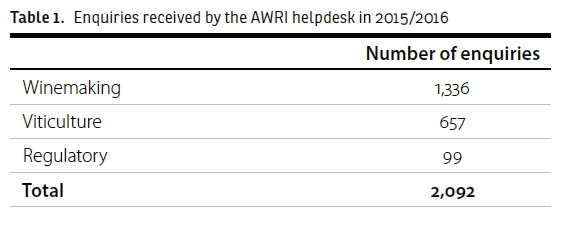
The AWRI’s technical helpdesk is a key service offered to grapegrowers and winemakers across Australia. It provides rapid, confidential support on a wide range of topics including winemaking, viticulture, health, regulatory and trade issues, delivered by a team with extensive industry experience and detailed knowledge of grape and wine technical issues. Industry personnel are able to contact the helpdesk by phone or email to ask advice, seek information or discuss issues. Samples can be submitted for problem solving investigations which may involve sensory, chemical or microbiological analysis. By identifying and quickly resolving issues as they arise, producers are able to minimise volume, quality and reputational losses while being assured that this service maintains strict confidentiality.
Over 2,000 enquiries were received during 2015/2016 (Table 1), approximately 10% more than the previous year. A database of all queries allows trends and spikes to be monitored, and appropriate responses coordinated and implemented as required. More than 80% of enquiries received during the year were answered within 24 hours.
Latest information
Winemaking enquiries
The majority of the winemaking enquiries received during the year were from wine companies and suppliers closely aligned with the wine industry, with the remaining queries originating from government organisations, students, legal practitioners and journalists. Approximately 20% of winemaking-related enquiries resulted in investigations, with samples requested and further analysis performed to identify the problem and recommend a process for remediation. Figure 10 shows the sources of winemaking enquiries in relation to the proportional volume of wine-grape production for each state/territory.
The type and number of enquiries received by the helpdesk varied considerably, largely dependent on the time of year. Vintage 2016 was another rapid and compressed vintage across many wine regions in Australia. Above average yields due to higher bunch numbers (caused by warm conditions in spring 2014) and a compressed vintage again placed stress on harvest and processing infrastructure. There was a delay in harvesting some blocks which resulted in high baumé fruit and higher alcohol wines. Ferment speeds tended to be fast, either to turn tanks over quickly to be prepared for the next batch of fruit or because of insufficient refrigeration capacity to cool both grapes and ferments. Some fermentation problems were also observed, with winemakers having little time or spare tank space to deal with stuck or sluggish ferments promptly.
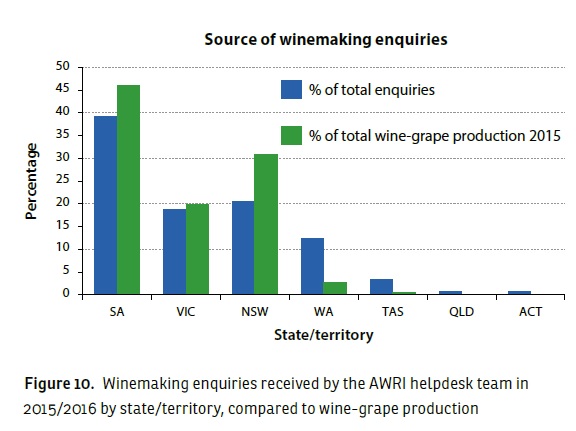
During January and February, bushfires occurred in some states, with Western Australia affected early in the season, and Tasmania following later, with some vineyards experiencing lingering smoke haze in the lead-up to harvest. Again, this created significant concern among growers and winemakers about smoke taint. A number of factors can influence the likelihood of a smoke event causing smoke taint in wine. Analytical data from testing volatile phenols and their non-volatile glycoside precursors can give a good indication as to whether or not fruit has been exposed to smoke. Sensory and chemical analysis of small-scale ferments can also assist in assessing the likely impact on final wines; however, this does take additional time to complete. Many calls to the helpdesk were taken during this period requesting assistance with interpreting analytical results. In some cases, where the results indicated that the wine contained only slightly higher levels than might be expected for non-smoke exposed vineyards, some winemakers very sensitive to smoke taint still saw signs of smoke-related characteristics.
For vintage 2016 the majority of analytical results were found to be similar to, or only slightly higher than, levels that might be expected for non-smoke exposed vineyards, making it difficult to use analytical data alone to determine the extent of any taint.
Viticultural enquiries
During the year, the viticulture team responded to 657 viticulture-related enquiries, an increase of about 35% on the previous year. Around one-third of viticulture queries related to sustainability matters. The next most common topics for queries were agrochemicals (16%), vineyard pests/diseases (9%), vineyard practices (8%) and viticulture in general (7%). Other common queries covered weather, grapevine varieties and smoke taint.
Agrochemical queries were dominated by questions about captan, a commonly used fungicide that was removed from the list of ‘recommended’ products for export wine due to a regulatory change proposed by the European Union. Fungal diseases made up about two-thirds of the pest/disease-related queries with most of the remainder being about insects. Issues with Botrytis were seen particularly from NSW following the wet weather shortly before harvest. Queries about trunk diseases were also relatively common.
For the most part viticulture queries to the AWRI helpdesk service followed national plantings, that is to say that about half of the queries were generated in SA where 50% of vineyard plantings are located. The exception to this was in Victoria where less than 10% of queries originated, even though that state is home to over 17% of the vineyard area. The states/territories with a larger share of queries than their planted area would suggest are those with smaller plantings, namely the ACT, Tasmania and Queensland.
Regulatory enquiries
There were 99 regulatory-related enquiries during 2015/2016. One area of interest during the year was questions about health and nutrition labelling for wine and wine products. Broadly these questions can be divided into the topics of alcohol, allergens, preservatives and health and nutrition statements for Australia, which all fall under the auspices of the Australia and New Zealand Food Standards Code. As the incidence of food allergies and intolerances is increasing worldwide, sensitive consumers are looking into all aspects of their daily diet and this includes wine consumption. Common misconceptions about allergens in wine relate to histamine and sulfur dioxide. Other regulatory queries included:
- migration of phthalates from various packaging materials and consequent concentrations in wine including available analyses
- concentration and potential toxicity of elements such as arsenic, copper, fluoride, iron, lead and manganese in wine
- accuracy and legality of glucose-fructose measurements versus other methods for sugar measurement in wine
- methods for measurement of titratable acidity in wine
- Australian and international status of water additions in winemaking
- Australian and international methanol limits for wine and related toxicity
- organic wine standards and certification
- product specifications for DAP and tartaric acid preparations
- legality of compounds such as ascorbic acid versus erythorbic acid, aspergillopepsins, carboxymethyl cellulose, copper sulfate, dimethyl dicarbonate, resveratrol and tea tannins in Australia and international markets, including natural versus synthetic products.
Winemaking problem solving investigations
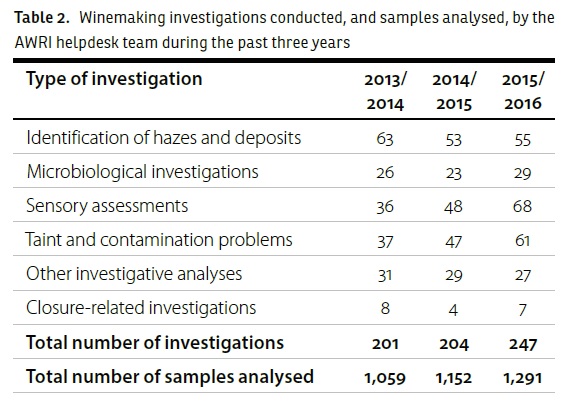
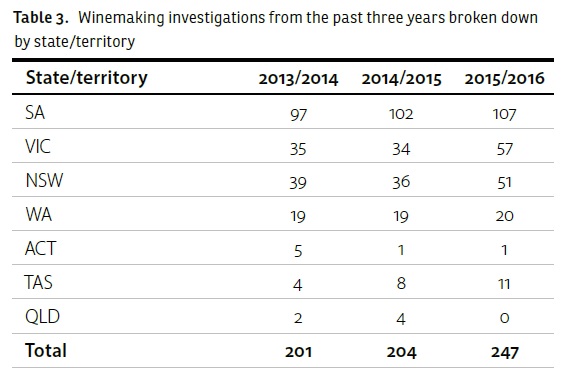
In 2015/2016 the AWRI helpdesk team conducted 247 winemaking problem solving investigations. This figure is more than 20% higher than the previous year and the highest number since 2006/2007 when 278 investigations were conducted. The extra investigations included more sensory assessments and taint/contamination investigations. The number of samples analysed as part of these investigations also increased by more than 10% this year (Table 2). A breakdown of the investigations conducted by state/territory is shown in Table 3. Trends are generally similar to previous years, with SA, Victoria and NSW accounting for the highest numbers of investigations. The number of investigations conducted for wineries located in Tasmania increased for the third year in a row. The sources of the winemaking investigations conducted compared with the volume of wine-grape production of the different states/territories is shown in Figure 11.
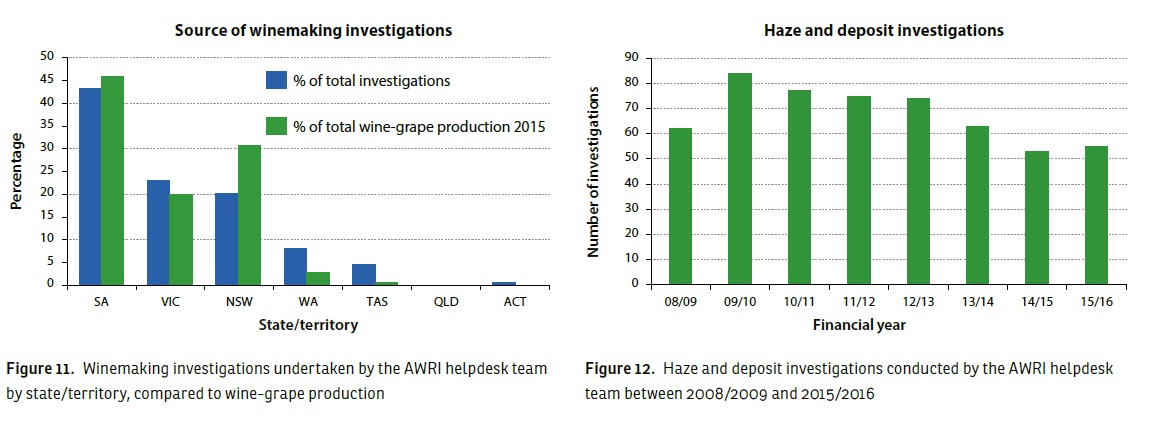
The total number of investigations conducted on wines affected by hazes and deposits continues to be substantial and was slightly higher than the previous year (Figure 12). More than 20% of the deposits identified this year were crystalline, with slightly more potassium hydrogen tartrate deposits than calcium tartrate deposits. Other deposits identified in significant numbers were protein hazes from heat-unstable wines (>15%) and yeast cells (>15%), most likely caused by ineffective filtration or contamination during packaging. There were two investigations which identified the presence of quercetin dihydrate crystals, which are easily distinguished by their fibrous and needle-like crystalline appearance. Quercetin dihydrate is one of the flavonol compounds that occur naturally in grape skins and leaves. Flavonol deposits in wine are relatively rare, but some viticultural practices such as increased sun exposure of fruit and machine harvesting can contribute to elevated levels of these compounds in wine (Ziemelis 1982). Quercetin glycosides are extracted from grape skins during fermentation and then hydrolyse under acidic wine conditions to release the free quercetin. The quercetin may then crystallise, incorporating water molecules in the process, and forma deposit. No predictive tests for quercetin dehydrate crystal formation are available.
The number of investigations conducted into microbiological instabilities also increased slightly this year (Figure 13). Stuck and sluggish fermentations were the most common of these. It is quite difficult to pinpoint the reason(s) behind stuck or sluggish fermentations due to the dynamic nature of grape juice fermentation; however early in vintage 2016 the helpdesk team began investigating stuck ferment wines to see if any specific compositional factors might be important this year. In particular, the team looked for unusual acidity or nutrient profiles, higher baumé levels and unusual vineyard microbial populations or agrochemical residues present due to rapid ripening of fruit. Several wine regions were also visited later in the vintage to try to understand the root causes behind stuck fermentation issues.
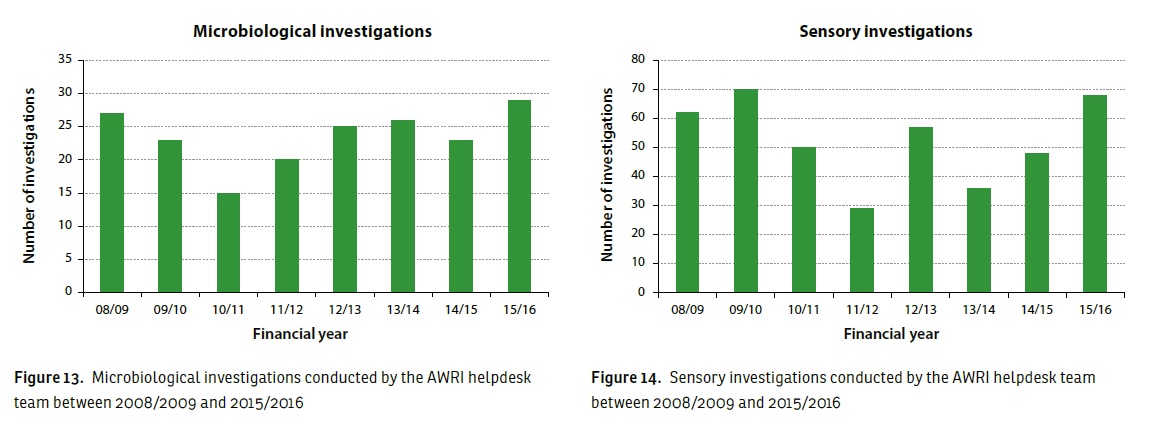
For the ferments that were examined, results revealed:
- Agrochemical residues from late sprays had not impeded fermentation.
- Sulfur dioxide levels in grapes and ferments were within acceptable ranges and therefore unlikely to have caused fermentation problems.
- Acidity levels, including organic acid profiles, were within typical ranges compared to other vintages. Compressed vintages can lead to pH and TA imbalances. A few wines did have volatile acidity levels >0.8 g/L which can have a negative effect on fermentation.
- Nutrient levels (YAN and amino acids) were considered typical and no sulfide issues occurred during fermentation.
All of these ‘typical’ results suggested that higher sugar and alcohol levels were likely to be the main causes of this year’s stuck or sluggish fermentations. Most winemakers had inoculated with alcohol-tolerant yeast strains, so strain choice did not appear to be a major factor, but winemakers did report that fermentations had been faster than usual. This may have increased stress on yeast, making it more difficult for them to finish fermenting the last 1-2 baumé of ferments. Lack of time and tank space to deal with stuck ferments immediately was also an issue.
Other issues investigated under the category ‘microbiological instabilities’ included wines with high volatile acidity, mousiness, stuck malolactic fermentations, wines not holding free sulfur dioxide (typically due to yeast growth), wines containing viable yeast and bacteria, and wines affected by Brettanomyces spoilage.
During 2015/2016 there were seven investigations relating to closures, compared to four the previous year. Most of the closure investigations related to wines leaking for reasons including refermentation, cork quality, damage during insertion or incorrect fill heights. In one investigation several different products were observed to have leaked upon arrival in China. After an extensive investigation looking at a number of physical parameters as well as chemical analyses, it was determined that the underlying cause of the leakage was related to insufficient ullage levels and the effects of temperature during transit. Ullage distance is the distance from the surface of the wine to the underside of the cork closure, with the bottle in an upright position. For wine bottled under vacuum, Amon and Simpson (1980) recommend a minimum ullage distance of at least 13 mm (measured at 20°C). If the ullage is too low and a wine is heated, the wine volume will expand, leaving no space, and the bottle pressure can increase to levels above 50 kPa.
Sixty-eight sensory investigations were carried out in 2015/2016 (Figure 14), an increase of >40% compared to the previous year. The types of problems were again quite diverse, and included wines exhibiting reductive characters, smoke taint, Brettanomyces spoilage characters, elevated levels of volatile acidity, indole, oxidation and mousiness. A small number of investigations related to dissolved carbon dioxide levels in both sparkling wines and still white and red wines.
Sixty-one ‘taints and contaminations’ investigations were carried out during 2015/2016 (Figure 15), a number that was nearly 30% higher than the previous year (47) and above the long-term average from 1999/2000 to 2015/2016 (46). This increase is concerning; however, when the cases were reviewed, apart from TCA (trichloroanisole or ‘cork taint’), which accounted for approximately 25% of the investigations, there was not one consistent issue but instead many different and varied problems. To address the problems being observed, eNews articles and discussions during workshops were used to inform winemakers about the taint/contamination issues seen, in particular the number of cases of ‘musty’/‘TCA-like’ characters identified in wines. Interestingly, a large percentage of these investigations identified winery water as the source of the contamination. A large proportion (~85%) of the investigations were carried out using GC-MS techniques. Of these, sixteen investigations were related to TCA taint from various sources, the most in this category. Other taints included hydraulic oil (seven investigations), grapeseed oil, cleaning products, brine contamination, halophenols, paint-related contamination (two investigations), turpentine and diesel contamination, burnt stator and smoke taint from bushfires. There was also one investigation into a wine with millipede taint and one where a frog was found in a wine tank.
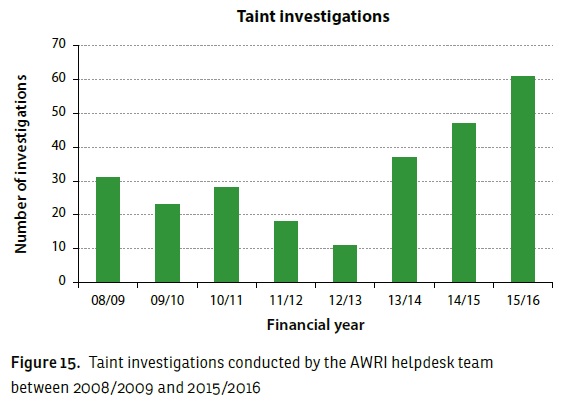
Investigations conducted under the category ‘other’ included pinking, questions of authenticity, filtration, polysaccharides, copper, tartaric acid purity and sparkling wine gushing upon opening.
Most unusual investigation
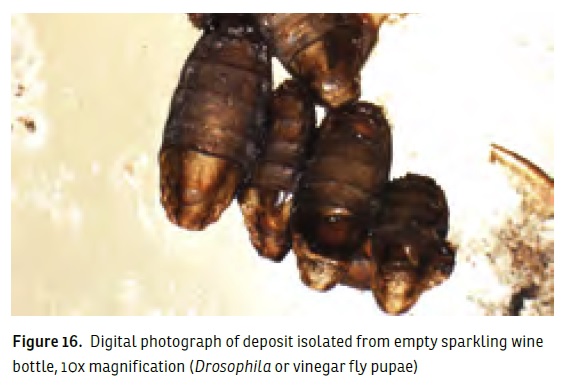
Project Team
Con Simos
Matt Holdstock
Adrian Coulter
Geoff Cowey
Marcel Essling
Randell Taylor
Creina Stockley
Paul Petrie
Gayle Baldock
Yoji Hayasaka
Markus Herderich
Find out more
AWRI Helpdesk
Winemaking
Viticulture
Regulatory information
Wine and health
Climate and environment
Reference
Amon, J.M., Simpson, R.F. 1986. Wine corks: a review of the incidence of cork related problems and the means for their avoidance. Aust. Grapegrower Winemaker 268: 63-80.
Ziemelis, G. 1982. Flavonol haze – a new form of wine instability arising from technological change. Clarke, J. ed. The Institute of Brewing (Australia and New Zealand section): Proceedings of the Seventeenth Convention; 7-12 March 1982; Perth, WA. Sydney, NSW: The Institute of Brewing: 75-76.

